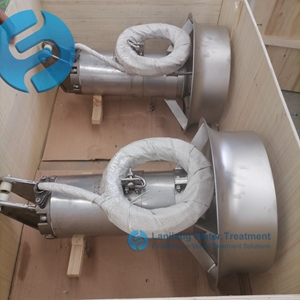The operation process of the sewage mixer mainly includes the following steps, which are designed to ensure the safe and efficient operation of the equipment and achieve the desired mixing effect:

First, prepare before operation
Check the equipment:
Make sure that the parts of the sewage mixer are firmly installed without loosening or damage.
Check whether the import and export pipes are unobstructed and not blocked.
Check whether the power line is normal, whether the motor and the control box are connected correctly, and the voltage is stable.
Cleaning up the environment:
Clean up the debris and oil around the sewage mixer to ensure the safety and cleanliness of the operating environment.
Personal Protection:
Operators should wear personal protective equipment such as safety helmet, protective glasses and gloves to prevent sewage splashing or mechanical injury.
Confirm pool status:
Verify that the pool to be stirred is full of water, and check that the water quality meets the mixing requirements.
Second, start the device
Turn on the power:
Turn on the power switch and start the control box.
Start the mixer:
Press the start button to start the sewage mixer. Observe the startup process of the device to ensure that there is no abnormal sound or vibration.
Third, adjust parameters
Adjusting speed:
Adjust the speed of the mixer as needed to achieve the best mixing effect. Different materials and process requirements may require different speeds.
Set time:
Set the appropriate mixing time according to the requirements of the mixing task. Ensure that the material is well mixed, while avoiding excessive mixing that can increase energy consumption or damage the material.
Fourth, operation monitoring
Observe the running status:
During the operation of the mixer, the operator should pay close attention to the operating state of the equipment, including whether the motor temperature, bearing temperature, sound and vibration are normal.
Handling exceptions in a timely manner:
If the equipment is found to have abnormal sound, vibration, temperature rise and other phenomena, it should be stopped immediately to check and troubleshoot.
Fifth, shutdown and cleaning
Normal shutdown:
After the mixing task is completed, first set the mixer speed to the lowest setting, and then press the stop button to stop. Cut the power and close the control box.
Cleaning equipment:
After shutdown, clean up the debris and oil around the equipment in time to keep the equipment clean. At the same time, check whether the mixing paddle and the inner wall of the container are residual materials, and clean them if they are.
Records and reports:
Make operation records and reports of the mixer, including equipment status, mixing effect, abnormal conditions and handling measures, etc., to provide reference for subsequent maintenance and improvement.
Sixth, precautions
Compliance with procedures:
The operator should strictly abide by the operating procedures and safety specifications of the sewage mixer to ensure the safety and effectiveness of the operation process.
Professional Training:
The operator must have the corresponding operation certificate or qualification certificate, and be qualified after professional training before performing operations.
Maintenance:
Regular maintenance of the sewage mixer, including checking the wear of the motor, reducer, bearing and other parts and timely replacement of lubricating oil. Ensure long-term stable operation and extended service life of the equipment.
By following and implementing the above steps and precautions, it can ensure the efficient and safe operation of the sewage mixer and achieve the expected mixing effect.
Nanjing LanJiang Water Treatment Equipment Co.,Ltd manufactures equipment for wastewater treatment. We were established in 2001. Since then, we designed and produced submersible mixers, top entry mixers, aerators and other wastewater treatment equipment.
Post time:2024-08-01